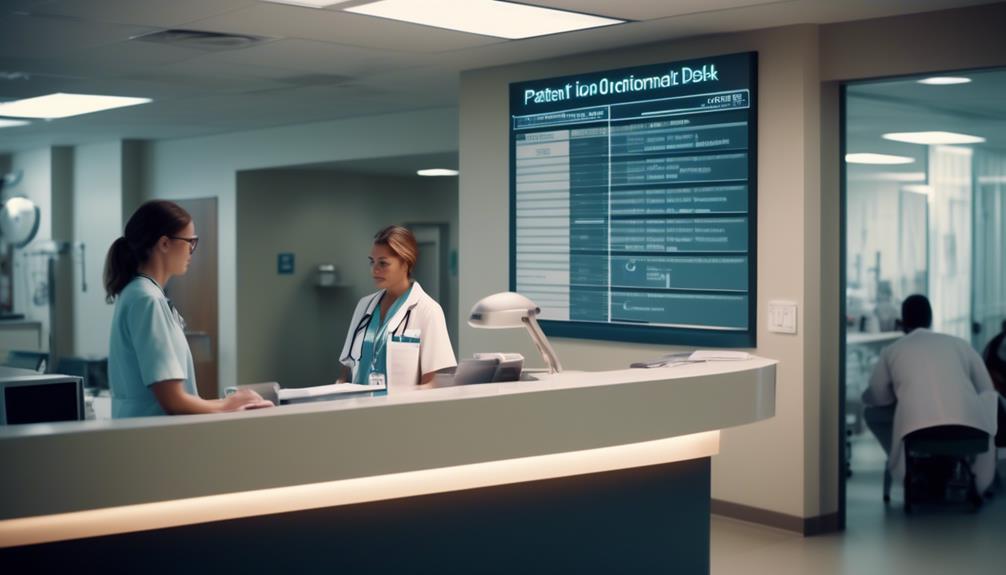In the realm of healthcare, managing patient information is akin to piecing together a complex puzzle where each element plays a crucial role. As you navigate the landscape of effective patient information management, you’ll find that key elements serve as the pillars upon which quality care is built. From integrating systems seamlessly to safeguarding data with utmost diligence, these components form the foundation of a patient-centric approach. But what truly makes these elements essential in the realm of healthcare?
Healthcare System Integration
How can healthcare system integration streamline patient information management for improved efficiency and quality of care? System integration plays a crucial role in addressing interoperability challenges and facilitating seamless data exchange within the healthcare sector. By implementing interoperability standards, different healthcare systems can communicate and share information effectively, leading to enhanced coordination of care and better patient outcomes.
One of the primary benefits of system integration is the ability to overcome interoperability challenges that arise due to the use of disparate systems and technologies across healthcare organizations. By establishing common interoperability standards, such as HL7 or FHIR, healthcare providers can ensure that patient data is accurately exchanged and utilized to support clinical decision-making.
Furthermore, system integration enables real-time access to comprehensive patient information, including medical history, test results, and treatment plans. This accessibility promotes care continuity and reduces the likelihood of medical errors. Overall, integrating healthcare systems through interoperability standards is essential for optimizing patient information management and delivering high-quality care efficiently.
Comprehensive Patient Records
By consolidating patient information from various healthcare systems through interoperability standards, a foundation is established for creating comprehensive patient records that enhance the continuity and quality of care. Record organization is crucial in ensuring that all relevant patient data is structured in a coherent manner for easy access and interpretation by healthcare providers. Efficient data management practices help in maintaining the accuracy and completeness of patient records, which is essential for making informed medical decisions.
Information retrieval plays a key role in comprehensive patient records by enabling healthcare professionals to quickly access pertinent information when needed. By implementing effective data sharing mechanisms, such as secure electronic health record systems, healthcare providers can collaborate more efficiently and ensure that patients receive coordinated care across different specialties and settings.
Detailed Medical History
When collecting a patient’s detailed medical history, it is crucial to ensure accuracy in recording all pertinent information. Make sure that the information is easily accessible when needed, but also maintain strict security measures to safeguard patient confidentiality. The detailed medical history serves as the foundation for comprehensive patient records, highlighting the importance of meticulous documentation.
Comprehensive Patient Records
To maintain effective patient information management, ensuring comprehensive patient records that encompass detailed medical history is essential. Comprehensive patient records not only provide insights into a patient’s current health status but also offer valuable information about their past conditions, treatments, and medications. By documenting detailed medical history, healthcare providers can make more informed decisions, leading to better patient care outcomes. It is crucial to adhere to data privacy regulations to safeguard sensitive patient information within these records. Additionally, proper record retention practices should be followed to ensure that patient records are securely stored and easily accessible when needed. Emphasizing the importance of comprehensive patient records with detailed medical history contributes to efficient healthcare delivery and improved patient safety.
Importance of Accuracy
Accuracy in detailed medical history is crucial for ensuring optimal patient care outcomes. To achieve this, data verification and error prevention are paramount:
- Data Verification: Double-checking patient information ensures that the medical history is complete and accurate, reducing the risk of misdiagnosis or inappropriate treatment.
- Error Prevention: By ensuring that all details are accurate and up to date, healthcare providers can avoid potential mistakes in diagnosis or treatment plans.
- Thorough Documentation: Comprehensive and precise documentation of a patient’s medical history aids in providing the best possible care and facilitates effective communication among healthcare team members.
Maintaining accuracy in detailed medical records is foundational to delivering high-quality healthcare and improving patient safety.
Accessibility and Security
Maintaining secure and easily accessible detailed medical histories is essential for ensuring efficient patient care and safeguarding sensitive information. Accessibility enhancement plays a crucial role in allowing healthcare providers quick access to pertinent patient data. By implementing user-friendly systems and interfaces, medical professionals can retrieve accurate information promptly, leading to better-informed decision-making and improved patient outcomes. Additionally, data encryption is a vital component of ensuring the security of detailed medical histories. Encrypting sensitive patient information adds an extra layer of protection against unauthorized access, reducing the risk of data breaches and maintaining patient confidentiality. Prioritizing accessibility enhancement and robust data encryption measures are key steps in managing detailed medical histories effectively while upholding patient privacy and security.
Personalized Treatment Plans
Crafting individualized treatment plans tailored to each patient’s unique needs and medical history is crucial in providing effective and personalized care. Personalized care ensures that patients receive treatments that are specific to their condition, enhancing the likelihood of successful outcomes.
Key Elements for Personalized Treatment Plans:
- Comprehensive Assessment: Begin by conducting a thorough assessment of the patient’s medical history, current health status, and any relevant lifestyle factors. This information forms the foundation for creating a personalized treatment plan.
- Collaborative Approach: Involve the patient in decision-making processes to tailor the treatment plan according to their preferences, values, and goals. Collaboration fosters a sense of ownership and promotes adherence to the treatment regimen.
- Regular Monitoring and Adjustments: Continuously monitor the patient’s progress and make necessary adjustments to the treatment plan based on their response. Regular follow-ups and assessments ensure that the treatment remains tailored to the patient’s evolving needs.
Accurate Billing Information
To ensure smooth financial transactions and streamline the payment process, it is essential to input correct billing information accurately. Accurate billing information is crucial for avoiding billing errors that could lead to delays in payment processing and reimbursement. When billing errors occur, it can result in confusion for both the healthcare provider and the patient, potentially impacting the overall efficiency of the revenue cycle.
Updated Insurance Details
Ensuring your insurance card is up to date is crucial for accurate billing and smooth healthcare processes. Regularly verifying your insurance details and promptly updating policy coverage changes can prevent billing discrepancies and ensure you receive the maximum benefits available to you. Stay proactive in managing your insurance information to streamline your healthcare experience and minimize any potential financial burdens.
Insurance Card Verification
Efficiently verifying updated insurance details on patients’ insurance cards is essential for accurate billing and seamless healthcare service provision. To ensure smooth insurance card verification, follow these key steps:
- Eligibility Verification: Confirm the patient’s insurance coverage and validate their eligibility for services to prevent claim denials.
- Copayment Requirements: Verify the copayment amount required from the patient for each visit or service to avoid billing discrepancies.
- Coverage Limits: Understand the scope of coverage limits within the patient’s insurance plan to prevent unexpected out-of-pocket expenses and facilitate proper claims processing.
Policy Coverage Updates
For accurate and seamless patient information management, stay updated with policy coverage changes, including any updated insurance details. Regularly review your insurance policy for any modifications in coverage limitations or reimbursement procedures. Understanding these policy changes is crucial for smooth claim processing and ensuring that you receive the appropriate benefits from your insurance provider. Make sure to update your insurance details promptly with your healthcare provider to avoid any delays or issues with claim submissions. Being proactive in keeping your policy information current can help streamline the billing process and prevent any misunderstandings that may arise due to outdated insurance information. Stay informed and proactive to navigate the complexities of insurance policies effectively.
Efficient Appointment Scheduling
To streamline your medical practice’s operations, optimizing the appointment scheduling process is crucial. Efficient appointment scheduling leads to improved efficiency and streamlined processes within your practice. Here are three key elements to consider:
- Utilize Online Appointment Scheduling: Implementing an online scheduling system allows patients to book appointments conveniently, reducing phone call volume and minimizing scheduling errors. This streamlines the process for both your staff and patients.
- Implement Automated Appointment Reminders: Use automated reminders via text, email, or phone calls to reduce no-show appointments. This not only helps in better utilization of your schedule but also enhances patient satisfaction by keeping them informed.
- Establish Clear Scheduling Policies: Clearly define your scheduling policies regarding cancellation, rescheduling, and late arrivals. By setting these expectations upfront, you can minimize disruptions and optimize your daily schedule efficiently.
Transition to Digital Format
When transitioning to a digital format for patient information management, consider the advantages of paperless record-keeping, such as improved organization and accessibility. Digitization offers benefits like enhanced security and efficiency in updating patient data. Ensure your staff receives proper training to effectively navigate and utilize the new digital system for seamless integration.
Paperless Record Keeping
Embrace the shift towards digital record-keeping for enhanced efficiency and accessibility in patient information management. By transitioning to paperless record-keeping, you can streamline processes and improve patient care. Here are three key aspects to consider:
- Document Scanning: Convert physical documents into digital files for easy storage and retrieval.
- Electronic Signatures: Implement electronic signature solutions to expedite authorization processes securely.
- Cloud Storage: Utilize secure cloud platforms for storing patient data, enabling convenient access from anywhere while ensuring backups are maintained.
Benefits of Digitization
Transitioning to a digital format offers numerous benefits in patient information management, revolutionizing the way healthcare providers store and access crucial data. Improved efficiency is a key advantage of digitization, as digital records can be quickly retrieved, updated, and shared among healthcare professionals, leading to faster and more coordinated patient care. Additionally, the shift to digital formats results in significant cost savings for healthcare facilities by reducing paper, printing, and storage expenses. With digital records, the need for physical storage space diminishes, freeing up valuable real estate within medical facilities. Embracing digitization not only streamlines information management processes but also enhances the overall quality of care provided to patients while optimizing operational costs.
Training for Staff
To effectively harness the benefits of digitization in patient information management, focusing on comprehensive training for staff is essential to ensure seamless integration and utilization of digital formats. When transitioning to digital formats, consider the following:
- Staff Development: Providing continuous training opportunities for your staff ensures they are well-equipped to handle digital patient information effectively.
- Improved Communication: Proper training fosters improved communication within the team, enhancing patient engagement and overall satisfaction.
- Enhanced Patient Engagement: Well-trained staff can utilize digital tools to engage with patients more efficiently, leading to better health outcomes and increased patient satisfaction.
Investing in staff training not only improves operational efficiency but also enhances the overall patient experience.
Emphasis on Data Accuracy
Maintaining precise and reliable data is paramount for effective patient information management. Data accuracy hinges on robust data validation processes and error prevention mechanisms. Implementing stringent data validation protocols ensures that the information entered is accurate and consistent. This involves cross-verifying data inputs against predefined rules and standards to flag any discrepancies promptly.
Moreover, error prevention strategies play a pivotal role in upholding data accuracy. By proactively identifying and rectifying errors at various stages, such as data entry or transmission, you can prevent inaccuracies from propagating throughout the system. Regular audits and quality checks are instrumental in identifying any anomalies or inconsistencies in the data, enabling timely corrective actions.
Emphasizing data accuracy not only enhances the quality of patient care but also bolsters the overall efficiency of healthcare operations. By fostering a culture that prioritizes data accuracy, you lay a solid foundation for reliable decision-making and improved patient outcomes. Remember, accurate data is not just a necessity but a cornerstone of effective patient information management.
Protecting Patient Privacy
Ensuring the accuracy and reliability of patient data sets a strong foundation for safeguarding patient privacy in healthcare operations. To enhance privacy safeguards and protect patient information effectively, consider the following key measures:
- Data Encryption: Implement robust data encryption techniques to secure patient data both at rest and in transit. Encryption helps prevent unauthorized access to sensitive information, adding an extra layer of protection against data breaches.
- Access Controls: Utilize access controls to restrict data access to authorized personnel only. By setting up user authentication protocols and strict permission levels, healthcare organizations can ensure that patient data is viewed and handled by approved individuals.
- Regular Audits: Conduct regular audits and assessments of privacy protocols to identify any vulnerabilities or gaps in the system. By proactively monitoring and evaluating data protection measures, healthcare providers can stay ahead of potential privacy risks and address them promptly.
Ensuring HIPAA Compliance
How can healthcare organizations effectively align their practices with HIPAA regulations to safeguard patient information and ensure compliance? One crucial aspect is providing comprehensive HIPAA training to all staff members. This training should cover the importance of patient privacy, the specifics of HIPAA regulations, and the consequences of non-compliance. Regular refresher courses can help keep everyone up to date on the latest requirements and best practices.
In addition to training, implementing robust data encryption measures is essential for HIPAA compliance. Encrypting sensitive patient information both at rest and in transit adds an extra layer of protection against unauthorized access. Healthcare organizations should utilize encryption technologies that comply with HIPAA standards to safeguard patient data effectively.
Robust Data Security Measures
To fortify the protection of patient information, healthcare organizations must implement robust data security measures that go beyond encryption protocols to safeguard against potential breaches. Here are three crucial steps to enhance data security:
- Data Encryption and Security Protocols: Utilize advanced encryption methods such as AES-256 to encode sensitive patient data both in transit and at rest. Implement stringent security protocols to control access levels, use multi-factor authentication, and regularly update encryption keys to strengthen data protection.
- Cybersecurity Training: Conduct regular training sessions for all staff members to educate them on identifying phishing attempts, malware threats, and social engineering techniques. Enhance employee awareness of cybersecurity best practices to minimize the risk of human error leading to data breaches.
- Risk Assessment: Perform comprehensive risk assessments to identify vulnerabilities in your data systems and processes. Regularly evaluate and update security measures based on the findings to proactively mitigate potential risks and ensure the integrity of patient information.
Frequently Asked Questions
How Do Patient Information Management Systems Handle Language Barriers and Cultural Differences in Healthcare Settings?
When managing patient information, systems handle language barriers through interpreter services and multilingual resources. Cultural differences are addressed by promoting cultural competence and improving cross-cultural communication to ensure effective healthcare interactions and understanding.
What Measures Are in Place to Ensure Patients With Disabilities Have Equal Access to Their Medical Information?
To ensure patients with disabilities have equal access to their medical information, facilities offer accessible formats like braille or audio recordings. Communication support through sign language interpreters or text-to-speech software enhances understanding and engagement.
How Do Patient Information Management Systems Address the Challenges of Managing Mental Health Information and Maintaining Patient Confidentiality?
When managing mental health information, patient information management systems focus on data security and privacy. They ensure electronic records are accessible only to authorized individuals, maintaining patient confidentiality and complying with regulations to safeguard sensitive information.
What Protocols Are in Place to Handle Patient Information During Emergencies or Natural Disasters?
When emergencies strike, you might think chaos reigns. But in reality, healthcare facilities have solid protocols for emergency response and disaster recovery. Patient information is carefully managed to ensure quick access and minimal disruption.
How Do Patient Information Management Systems Handle the Sharing of Information Between Healthcare Providers and Institutions to Ensure Continuity of Care for Patients?
When handling patient information, systems ensure data security and interoperability for seamless sharing between providers and institutions. Electronic records and telemedicine facilitate efficient communication, fostering continuity of care and improved patient outcomes.




